#katherine plantagenet
Explore tagged Tumblr posts
Text










The signatures* of the monarchs of England/UK from 1066
*When there was no signature, I used their name as it appeared on a charter or letter from them.
The royal consorts
#I had a whole thing explaining who each person was in my other post but I think this one is pretty self-explanatory#mr bolingbroke what the hell is that#I think richard iii's is the most extra but victoria is a close second#elizabeth i's is not extra it is fabulous#elizabeth ii's signature looks so much like her mother's I thought I had the wrong one#I think that jane portrait is elizabeth but the one everyone uses is katherine parr so#normans#plantagenets#tudors#stuarts#hanoverians#windsors
288 notes
·
View notes
Text
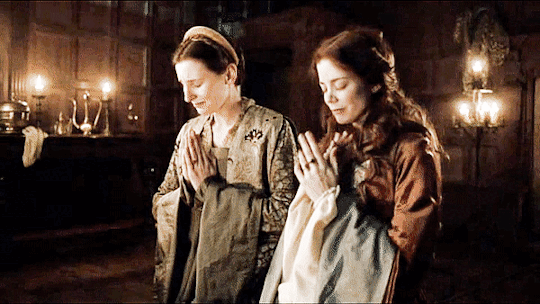
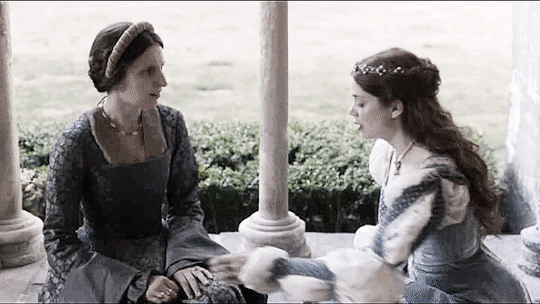
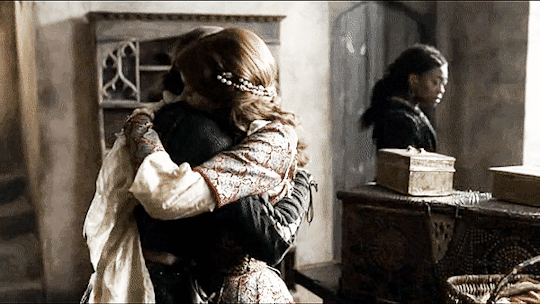
Katherine of Aragon & Margaret Plantagenet
They had known each other since Katherine first came to England. Margaret’s late husband, Richard Pole, had been Prince Arthur’s Lord Chamberlain, and she had accompanied him to Wales during the brief five-month marriage of Katherine and her first husband. Royal by birth, Margaret Pole was one of the most important ladies of high rank in the kingdom and one of the last Plantagenets at the Tudor court.
There a bond seems to have been forged between the two women, despite the fact that Katherine spoke little English and was 12 years younger than Margaret. The Spanish princess soon learned that her father had demanded the execution of Margaret’s brother before she arrived in England, and she was horrified. Feelings of guilt over the Earl of Warwick’s unjust execution pushed Katherine to seek Margaret’s friendship. Many years later, Margaret’s son, Reginald Pole, recorded that Katherine was “very much bound to recompense and requite us [the Pole family] for the detriment we had received on her account (although she was not in the least to blame for it), and to show us every kindness, having found by experience that in all her sorrows and afflictions, from no family of the realm had she ever received greater consolation than from ours, although for her sake we had received so many injuries”
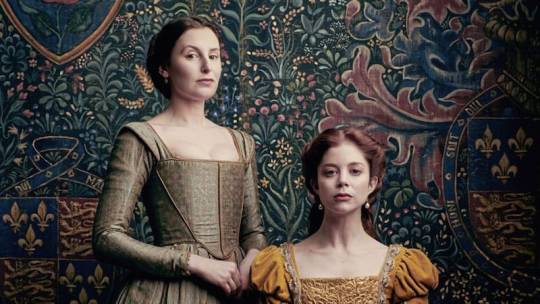
Arthur’s premature death at Ludlow parted them, but they continued to correspond until Henry VIII’s accession rescued Katherine from penurious widowhood and made her the queen consort she had always expected to be. Margaret had also known financial distress during this period (her husband died in 1504), but her loyalty and friendship were not forgotten. She came to court with her eldest son to attend Katherine’s coronation and was soon appointed one of the queen’s chief attendants. In 1512, possibly at his wife’s behest, Henry VIII granted Margaret’s petition for restoration of the earldom of Salisbury and she became a countess in her own right.
Katherine chose Margaret to be the governess of her daughter, Princess Mary. Margaret had formed a close bond with Katherine and treated her daughter with the same warmth. Katherine would gladly have seen a marriage between her daughter and her friend’s son Reginald. The Pole family fortunes crashed after Anne Boleyn became the second wife of Henry VIII. Not surprisingly, Margaret had sided with Katherine and Mary during the divorce struggle. Lady Salisbury was known for her devout Roman Catholic beliefs. When Princess Mary was declared a bastard in 1533, Margaret refused to give Mary's gold plate and jewels back to Henry VIII. When Mary's household was broken up at the end of the year, the sixty-year-old Margaret Pole asked to serve Mary at her own cost, but was not permitted. Five years after the death of Katherine of Aragon, Lady Salisbury was executed on the scaffold. Her death is one of the most tragic events in Henry VIII's reign.
Sources:
Linda Porter, Mary Tudor:The First Queen Sylvia Barbara Soberton, Great Ladies: The Forgotten Witnesses to the Lives of Tudor Queens
#catherine of aragon#katherine of aragon#catalina de aragon#margaret pole#margaret plantagenet#the spanish princess#charlotte hope#mary i of england#mary tudor#arthur tudor#henry viii#anne boleyn
96 notes
·
View notes
Note
Hi! Thanks for adding to this post! I think I’ve read that speculation about Katherine Haute sometime before too. Katherine Plantagenet’s young age (possibly younger than it’s usually assumed) also makes sense — I did not want to emphasise it that much in the ask I linked because I’m always afraid people will simply take it as me having a problem with Richard III (aka being a hater for the sake of being a hater) but yes, I think it’s very significant that her young age was emphasised. If we forced it, we could argue that she was at least twelve in 1484, the minimal age accepted by the Church for girls to marry, but Margaret Beaufort was married to her first husband, John de la Pole, when she was only six, so that’s certainly not an age guarantee. It’s a pity that she did not survive to the end of 1489, so she certainly died young too.
Hello! I was wondering if you know when Richard III's two known illegitimate children were born and who their mothers were?
I've noticed that Ricardians, whenever asked, usually resort to claiming that they were born before his marriage to Anne Neville. Which is possible, of course, but really there's no actual evidence or even indication of it? So I'm not sure why this claim is so persistently made other than the belief in Richard III's apparent "virtue" (which I've quoted because it's the word most commonly used)
Hi! Sorry for taking so long to reply! It's especially wild to see how it's so common to compare Richard's virtue to Edward IV's alleged lack of one. It is baffling to me that people don't realise that kind of thinking was entirely fabricated by Richard himself after his brother's demise so that his takeover could look more legitimate: a righteous man putting the corrupted kingdom in order. But what am I saying? According to them, propaganda was invented by Henry VII, so!
I like to point out that both brothers had almost the same number of acknowledged illegitimate children. And yes, despite some insistence to the contrary, it's entirely possible the illegitimate children Richard acknowledged were born during his marriage to Anne Neville, as I pointed out in this ask. We don't know for sure the identity of their mothers either, sadly.
18 notes
·
View notes
Text

How dear of you to let me out of jail
#the lion in winter#eleanor of aquitaine#henry ii plantagenet#katherine hepburn#peter o'toole#quick quick sketch done on the couch while rewatching my comfort family movie where everyone wants to stab each other
46 notes
·
View notes
Text
Book and Writing Update
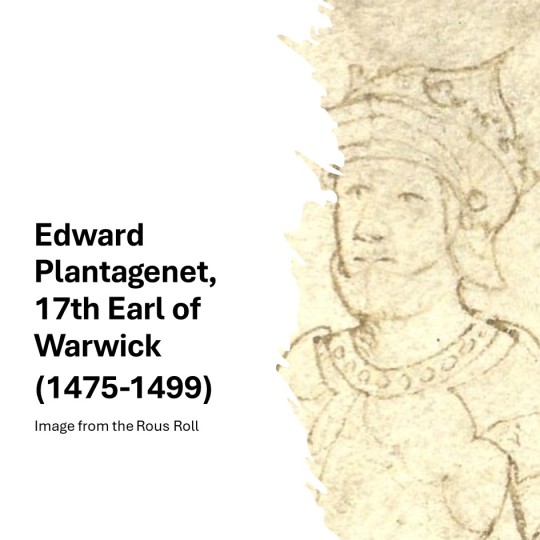
View On WordPress
#Anne Boleyn#Catherine Howard#Countess of Salisbury#Duke of Buckingha#Duke of Norfolk#Duke of Northumberland#Duke of Somerset#Earl of Essex#Earl of Surrey#Earl of Warwick#Edward Plantagenet#Edward Seymour#Edward Stafford#elizabethan rebellions#George Boleyn#helene harrison#Henry Howard#Jane Boleyn#Jane Grey#Jane Parker#John Dudley#Katherine Howard#Lady Jane Grey#Lady Rochford#Margaret Pole#owen emmerson#Pen and Sword#Robert Devereux#Thomas Howard#Thomas Seymour
0 notes
Text
My name is Mary Katherine Blackwood. I am eighteen years old, and I live with my sister Constance. I have often thought that with any luck at all I could have been born a werewolf, because the two middle fingers on both my hands are the same length, but I have had to be content with what I had. I dislike washing myself, and dogs, and noise. I like my sister Constance, and Richard Plantagenet, and Amanita phalloides, the deathcup mushroom. Everyone else in my family is dead.
Shirley Jackson, from 'We Have Always Lived in the Castle'
218 notes
·
View notes
Text
matilda was at her most relaxed when her hands were busy. she was born a restless child, and much to her governess' both fear and relief, was only quelled when there was a sewing needle in hand. the prisenhof roared with merchants vying for the count's attention and ambassadors vying for his daughter's hand on behalf of their liege. matilda would not know any of it, for she had taken up weaving: the repetitive motions, the friction of the wool between her fingers steadied her heartbeat and cleared her mind. even when she'd been secured for the plantagenet heir, she would not put down her needle. her chef d'oeuvre was a shawl of fine flemish raven-colored wool annointed with exquisite gold thread, but there was more tenderness in every stitch of the simple doublet she'd created for her prince.
she would not know that harry would only wear it a few times, the piece tucked away in one of the numerous trunks holding her belongings, mostly clothes. they had been taken ahead of them to their lodgings after the unsteady journey to paris. despite the rocky terrain and the unforgiving waves of the channel, matilda did her best to steady her hands but arrived at france's shores with more than a few pricked fingers. scathed hands quickly found themselves folded in prayer at the feet of the pope, and thankful feet swiftly carried her from the cathedral, and into a carriage.
after a refreshing moment in plantagenet apartments, seemingly empty of its inhabitants, matilda could not stand a moment alone even if she was previously crammed into a pew with foreign nobles. as she roamed the hallways she paused to briefly exchange niceties with members of the ottoman retinue before finding katherine in the courtyard, her eyebrows furrowed. she stood a silent moment beside her, basking in the parisian sun. having just missed the words that escaped her lips, matilda offered instead: "i find myself in need of amusement — or at least, distraction — in order to acclimate to our new surroundings. care to join me?"

Post type || Open Starter
Location || hôtel saint-pol courtyard
Katherine thought had envisioned it in her mind so clearly, this grand summit that would bring together all the important bloodlines in Paris. The city that would star as the center of the very earth for the time they were all present. She had painted the faces of known royals in the canvas of her mind, in ballrooms and tournaments, for the entire journey to France. The trip had taken so long she could have managed to create half a novel. It was a welcome escape from the endless fields of grass, rocky cliffs and calm blue waters. And it let her prepare, or at least so she thought. Because it turned out, what her mind could picture on its own was hardly a spec of the grandeur that awaited.
If it hadn’t been for her mother’s many lessons, she doubted she could have kept her face as seamless as she had during the church gathering. Her mind went through many stages that first day. During the ceremony she came to terms with the reality that she had been absolutely clueless as to what divinity truly looked like. Nor had she had any clue of what splendor mankind could create. As her lips mimicked the latin words she had spoken so many times before, and she watched her father receive the gilded insignia, she failed to recall a time in her life in which she had felt as small and unimportant. And in silence she made a promise to herself that it was not the feeling she would leave the country with. For her own sake, as well as that of England.
A night of restless sleep did not help in shaking the feeling from the day before, nor did breakfast. Her father had already left to attend meetings of importance, and both her sisters had vanished as well. Their energy seemingly had not run out like hers had. - Apple in hand, she made her way out into the courtyard. Her gaze scanning the surroundings, that somehow looked quite unlike the night before. Trying to figure out in which direction to go, and if she was in need of either a carriage ride or a horse to reach her desired destination. “How do these people all seem so certain as to where they are heading?” she mumbled underneath her breath, as she stood still a little off the center of the courtyard. Trying to make up her mind as to where her sisters could have gone.
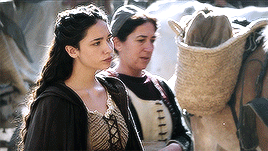
7 notes
·
View notes
Text


𓅃 ANNE BOLEYN WEEK 2024 𓅃
day four | favourite Anne motto
“Ainsi sera, groigne qui groigne”, which translates to “Let them grumble, that is how it is going to be”. Anne made use of this motto for a few weeks in around late 1529/early 1530. Anne had the motto embroidered on her servants’ livery ... Anne may only have used to for a few weeks, but a piece of embroidery featuring the motto has survived. The piece, which is thought to have been a cupboard cloth, has an oval design with the motto displayed in its border .. in the middle is of Anne Boleyn’s white falcon pecking at a pomegranate, the symbol of Katherine of Aragon ... The falcon is also perched on a stock, or tree stump, a Plantagenet badge, from which red and white roses spring, symbolising Anne bringing fertility to Henry VIII’s previously barren stock. The motto and the accompanying image give us insight into how Anne Boleyn was feeling at the time, her frustration at the situation, her impatience, her defiance at those who were painting her as a usurper and wh*re, and clearly her anger towards Katherine of Aragon. - Claire Ridgway, The Anne Boleyn Files
AINSI SERA GROIGNE QUI GROIGNE (LET THEM GRUMBLE; THAT IS HOW IT IS GOING TO BE)
62 notes
·
View notes
Text
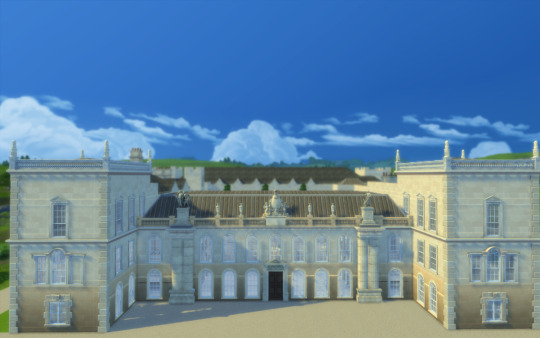

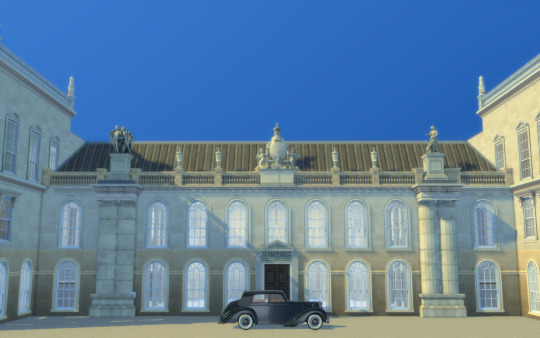

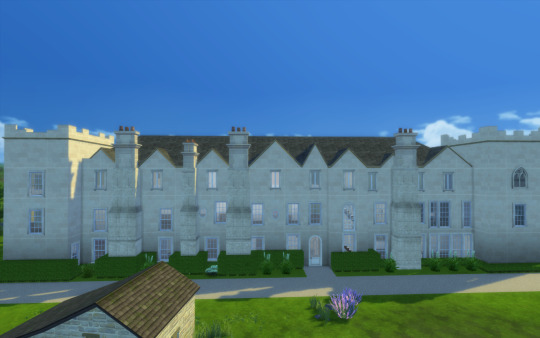
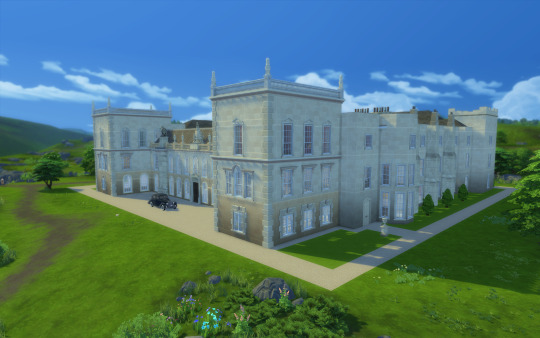
Grimsthorpe Castle
Hi guys!!
I'm sharing another grand english state!
House History: The building was originally a small castle on the crest of a ridge on the road inland from the Lincolnshire fen edge towards the Great North Road. It is said to have been begun by Gilbert de Gant, Earl of Lincoln in the early 13th century. However, he was the first and last in this creation of the Earldom of Lincoln and he died in 1156. Gilbert's heyday was the peak time of castle building in England, during the Anarchy. It is quite possible that the castle was built around 1140. However, the tower at the south-east corner of the present building is usually said to have been part of the original castle and it is known as King John's Tower. The naming of King John's tower seems to have led to a misattribution of the castle's origin to his time.
Gilbert de Gant spent much of his life in the power of the Earl of Chester and Grimsthorpe is likely to have fallen into his hands in 1156 when Gilbert died, though the title 'Earl of Lincoln' reverted to the crown. In the next creation of the earldom, in 1217, it was Ranulph de Blondeville, 4th Earl of Chester (1172–1232) who was ennobled with it. It seems that the title, if not the property was in the hands of King John during his reign; hence perhaps, the name of the tower.
During the last years of the Plantagenet kings of England, it was in the hands of Lord Lovell. He was a prominent supporter of Richard III. After Henry VII came to the throne, Lovell supported a rebellion to restore the earlier royal dynasty. The rebellion failed and Lovell's property was taken confiscated and given to a supporter of the Tudor Dynasty.[2]
The Tudor period
This grant by Henry VIII, Henry Tudor's son, to the 11th Baron Willoughby de Eresby was made in 1516, together with the hand in marriage of Maria de Salinas, a Spanish lady-in-waiting to Queen Catherine of Aragon. Their daughter Katherine inherited the title and estate on the death of her father in 1526, when she was aged just seven. In 1533, she became the fourth wife of Charles Brandon, 1st Duke of Suffolk, a close ally of Henry VIII. In 1539, Henry VIII granted Charles Suffolk the lands of the nearby suppressed Vaudey Abbey, founded in 1147, and he used its stone as building material for his new house. Suffolk set about extending and rebuilding his wife's house, and in only eighteen months it was ready for a visit in 1541 by King Henry, on his way to York to meet his nephew, James V of Scotland. In 1551, James's widow Mary of Guise also stayed at Grimsthorpe. The house stands on glacial till and it seems that the additions were hastily constructed. Substantial repairs were required later owing to the poor state of the foundations, but much of this Tudor house can still be seen today.
During Mary's reign the castle's owners, Katherine Brandon, Duchess of Suffolk (née Willoughby) and her second husband, Richard Bertie, were forced to leave it owing to their Anglican views. On Elizabeth's succeeding to the throne, they returned with their daughter, Susan, later Countess of Kent and their new son Peregrine, later the 13th Baron. He became a soldier and spent much of his time away from Grimsthorpe.
The Vanbrugh building
By 1707, when Grimsthorpe was illustrated in Britannia Illustrata, the 15th Baron Willoughby de Eresby and 3rd Earl Lindsey had rebuilt the north front of Grimsthorpe in the classical style. However, in 1715, Robert Bertie, the 16th Baron Willoughby de Eresby, employed Sir John Vanbrugh to design a Baroque front to the house to celebrate his ennoblement as the first Duke of Ancaster and Kesteven. It is Vanbrugh's last masterpiece. He also prepared designs for the reconstruction of the other three ranges of the house, but they were not carried out. His proposed elevation for the south front was in the Palladian style, which was just coming into fashion, and is quite different from all of his built designs.
The North Front of Grimsthorpe as rebuilt by Vanbrugh, drawn in 1819. Vanbrugh's Stone Hall occupies the space between the columns on both floors.
Inside, the Vanbrugh hall is monumental with stone arcades all around at two levels. Arcaded screens at each end of the hall separate the hall from staircases, much like those at Audley End House and Castle Howard. The staircase is behind the hall screen and leads to the staterooms on the first floor. The State Dining Room occupies Vanbrugh's north-east tower, with its painted ceiling lit by a Venetian window. It contains the throne used by George IV at his Coronation Banquet, and a Regency giltwood throne and footstool used by Queen Victoria in the old House of Lords. There is also a walnut and parcel gilt chair and footstool made for the use of George III at Westminster. The King James and State Drawing Rooms have been redecorated over the centuries, and contain portraits by Reynolds and Van Dyck, European furniture, and yellow Soho Tapestries woven by Joshua Morris around 1730. The South Corridor contains thrones used by Prince Albert and Edward VII, as well as the desk on which Queen Victoria signed her coronation oath. A series of rooms follows in the Tudor east range, with recessed oriel windows and ornate ceilings. The Chinese drawing room has a splendidly rich ceiling and an 18th-century fan-vaulted oriel window. The walls are hung with Chinese wallpaper depicting birds amidst bamboo. The chapel is magnificent with superb 17th-century plasterwork.
More history: https://en.wikipedia.org/wiki/Grimsthorpe_Castle


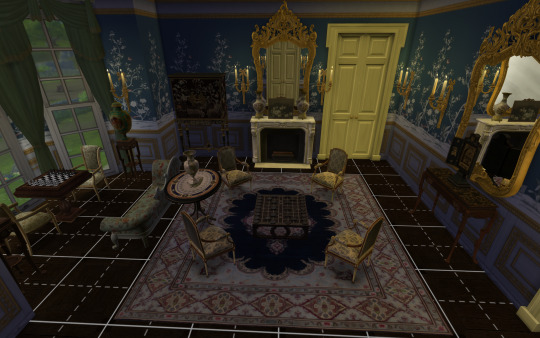
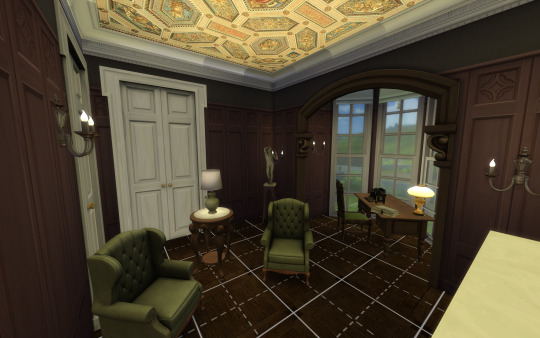
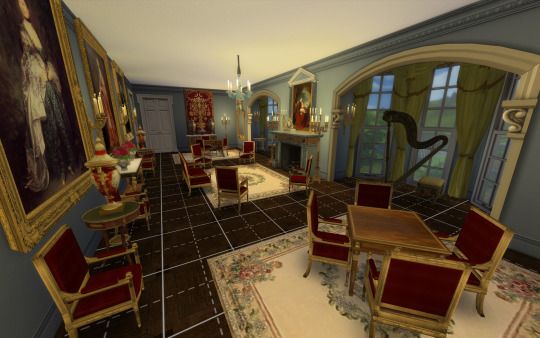
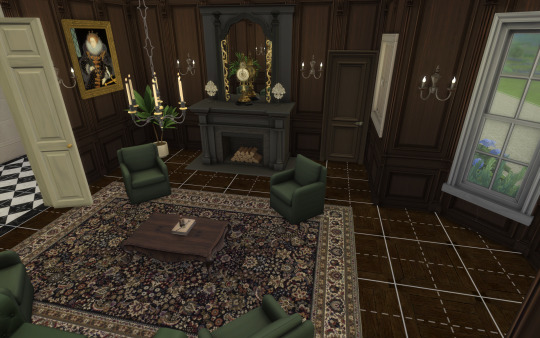
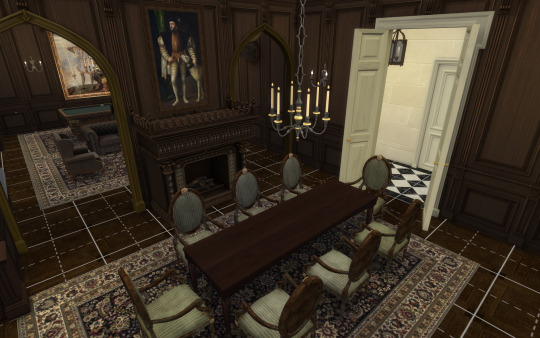
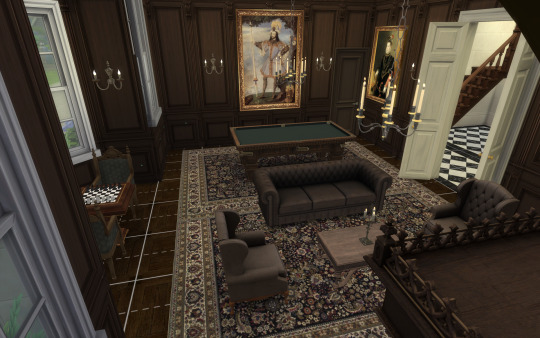
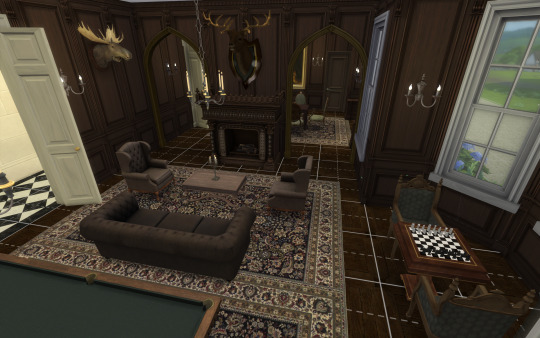

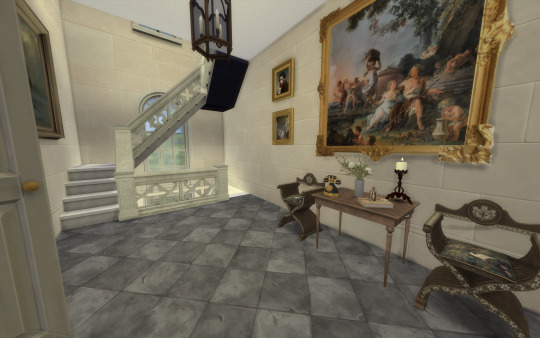
This house fits a 64x64 lot and features several impressive rooms, more than 29 bedrooms, a servants hall and several state rooms!
I only decored some of the main rooms, for you to have a glimpse of the distribution. The rest is up to you, as I have stated that I do not like interiors :P
Be warned: I did not have the floor plan for the tudor rooms, thus, the distribution is based on my own decision and can not fit the real house :P.
You will need the usual CC I use: all of Felixandre, The Jim, SYB, Anachrosims, Regal Sims, TGS, The Golden Sanctuary, Dndr recolors, etc.
Please enjoy, comment if you like it and share pictures with me if you use my creations!
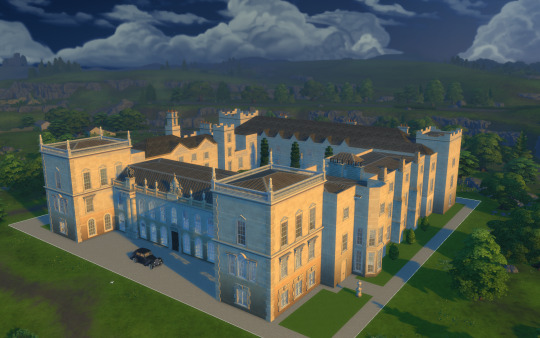








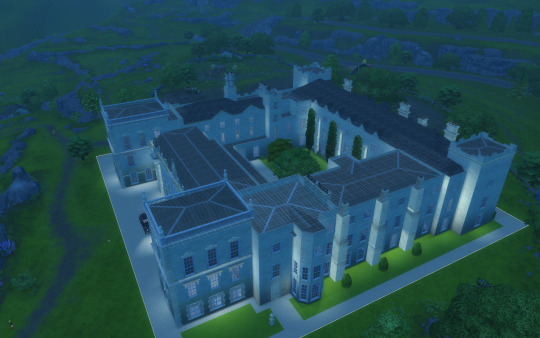

DOWNLOAD (Early acces: June 30) https://www.patreon.com/posts/grimsthorpe-101891128
#sims 4 architecture#sims 4 build#sims4#sims4play#sims 4 screenshots#sims 4 historical#sims4building#sims4palace#sims 4 royalty#ts4 download#ts4#ts4 gameplay#ts4 simblr#ts4cc#ts4 legacy#sims 4 gameplay#sims 4 legacy#sims 4 cc#thesims4#sims 4#the sims 4#sims 4 aesthetic#ts4 cc#english manor
41 notes
·
View notes
Note
can you name all 59 women
1. Anne Bonny: a lesbian
2. Mary Read: a lesbian
3. Mary Read again: an abusive, cheating wife
4. Mary, Queen of Scots: a lesbian. (But also not a lesbian because Hester Mary MacKenzie was also her concubine.)
5. Isabella 'Bella' Baldwin: a lesbian
6. Queen Elizabeth of Parma, also known as Isabelle d'Este, was the Empress of Modena. She's one of several queens whose non-biological children were legitimized by the church.
7. Mary, Queen of France (before and during her marriage to Henry III).
8. Charlotte of Savoy: a lesbian
9. Elizabeth of York, also Elizabeth Stuart: a lesbian
10. Anna Ivanovna Demushkin: a lesbian (Ivan the Terrible's wife, as well as Mary Queen of Scots')
11. Mary, Duchess of Orleans: a lesbian
12. Mary, Duchess of Orleans again: a lesbian
13. Isabella of France: a lesbian
14. Margaret of Anjou, wife of Francis Plantagenet: a lesbian.
15. Mary 'Mary of Guise', daughter of Margaret of Anjou and Francis Plantagenet: a lesbian
16. Queen of Denmark: a lesbian (Anne's daughter, Sophie of Poland and Denmark)
17. Catherine Howard: a lesbian
18. Katherine Howard: a lesbian
19. Mary, Queen of England: a lesbian (Mary Tudor)
20. Eleanor of Austria, daughter of Ferdinand and Isabella: a lesbian (Mary Tudor's daughter, also Queen of England)
21. Mary, Queen of Bohemia: a lesbian
22. Catherine Parr: a lesbian
23. Eleanor of Austria, again: a lesbian (Mary Tudor's daughter, also queen of England)
24. Mary Tudor: a lesbian
25. Queen of Scots: a lesbian
26. Catherine Parr again: a lesbian
27. Christine de Bourgogne: a lesbian, as well as a queen of France.
28. Jane Seymour, wife of Thomas Seymour and mother of Edward Seymour. Also a lesbian.
29. Mary Stuart: a lesbian
30. Isabella of Castile: a lesbian
31. Mary Stuart again, daughter of Mary I of England: a lesbian
32. Jane Seymour again: lesbian (Edward Seymour's mom)
33. Anne Fitzwilliam, Duchess of Norfolk: a lesbian
34. Barbara Tacy, Countess of Pembroke: a lesbian
35. Mary Tudor again: a lesbian. (Mary Stuart's daughter again)
36. Jane Buckley: a lesbian
37. Catherine Parr: Elizabeth Howard, Parr's daughter, was Queen of England after her mother's death and died without an heir.
38. Margaret Cecil: a lesbian
39. Anna of Cleves: Anne Beaton, wife of Frederick V, Elector of Saxony and of James I and Mary, Queen of Scots; and her granddaughter, Lady Jane Grey, daughter of King Henry VIII and Edward Seymour.
40. Henrietta Maria Stuart: lesbian
41. Anne of Cleves: lesbian
42. Mary Queen of France: lesbian
43. Mary Queen of France again: a lesbian
44. Margaret, Countess of Lennox: lesbian
45. Elizabeth Howard: another lesbian
46.
Anne Stafford: a lesbian
47.
Jane Stafford: a lesbian
48. Jane Seymour again: a lesbian
49. Mary Stuart, Queen of Scots: lesbian
50. Princess Margaret: a lesbian
51. Anne of Cleves again, this time as a mother: Mary Tudor's daughter; Queen of England for less than a month in 1553
52.
Jane Stafford again: lesbian
53. Margaret Howard, Countess of Stafford: lesbian
54. Lady Jane Grey again: a lesbian
55. Princess Anne: a lesbian. (Princess of Portugal and the two Marianas, of Portugal and England.)
56. Elizabeth Howard again: lesbian
57. Margaret of Anjou, Lady of Woodville, wife of Ralph Neville, son of the Duke of Northumberland (Henry Tudor).
58.
164 notes
·
View notes
Text
The problem is that there's an extreme paucity of primary sources on Katherine, which makes it difficult to manage a full length biography. Alison Weir's biography got quite a lot of negative reviews on the basis there was really not enough information on Katherine for a biography and she had to do a lot of guessing.
Katherine's father and first husband were both of very minor aristocratic status and not particularly wealthy or prominent. So, they were not mentioned by contemporary chroniclers and few of their families' letters or charters have been preserved.
A lack of primary sources is pretty typical for medieval mistresses. Little is also known of Rosamund de Clifford, Ida de Tosny, Biette de Cassinel, Alice Perrers, Odette de Champdivers, or Jane Shore and a number of famous medieval bastards, such as Geoffrey, Archbishop of York, and Joan, Lady of Wales, were born to women about whom we know nothing but their given names. Geoffrey's mother is identified is as a woman named "Ykenai" and Joan's mother is only named as "Clemence".
Why are there so few non-fiction books on Katherine Swynford? The most recent bio I know of is an Alison Weir book from like 10+ years ago. How are medieval historians not all over that? She should be as oversaturated as Anne Boleyn
26 notes
·
View notes
Text
Round 1
It was a queer, sultry summer, the summer they electrocuted the Rosenbergs, and I didn't know what I was doing in New York.’
-The Bell Jar, Sylvia Plath
My name is Mary Katherine Blackwood. I am eighteen years old, and I live with my sister Constance. I have often thought that with any luck at all I could have been born a werewolf, because the two middle fingers on both my hands are the same length, but I have had to be content with what I had. I dislike washing myself, and dogs, and noise. I like my sister Constance, and Richard Plantagenet, and Amanita phalloides, the death-cup mushroom. Everyone else in my family is dead.
-We Have Always Lived in the Castle, Shirley Jackson
How does one describe Artemis Fowl? Various psychiatrists have tried and failed.
-Artemis Fowl, Eoin Colfer
#books#polls#reading#round 1#tournament poll#the bell jar#sylvia plath#we have always lived in the castle#shirley jackson#artemis fowl#eoin colfer
94 notes
·
View notes
Text
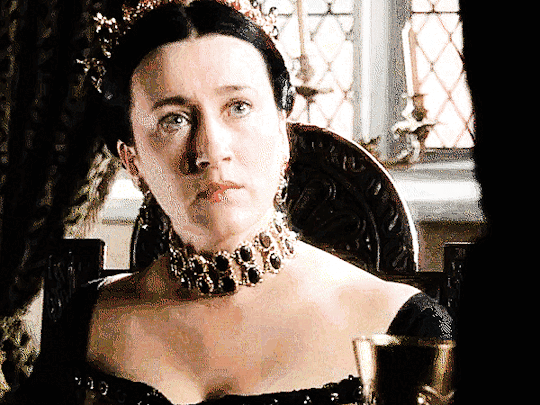
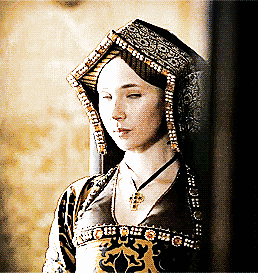
Katherine of Aragon & Gertrude Courtenay
Gertrude was daughter of William Blount, fourth Baron Mountjoy, a distinguished humanist scholar and chamberlain to Katherine of Aragon. As the daughter of such an esteemed gentleman at court, Gertrude received an outstanding education and served Katherine of Aragon as one of her maids of honor. The Queen oversaw the education of her young charges, so Gertrude benefitted from the royal patronage. In 1519, she married to Henry VIII’s first cousin Henry Courtenay, Earl of Devon. Gertrude was the wife and mother of the last Plantagenets at the Tudor court.
Gertrude was one of Queen Katherine of Aragon's attendants at the Field of the Cloth of Gold in 1520. If the Chateau Vert rings any bells it’s probably because it was the masque that saw Anne Boleyn, freshly returned from France, debuting at the Tudor court in March 1522. A little-known fact is that Gertrude Courtenay also took part in it, playing the role of Honour. In 1525, Gertrude’s star was on the rise once again when her husband was created the Marquess of Exeter, making Gertrude a Marchioness.

Gertrude was among the key political players of Henry VIII’s court during the infamous annulment, known as the Great Matter, commencing in 1527 and ending in 1536. The Marchioness of Exeter was among the high-profile ladies-in-waiting who staunchly supported Katherine of Aragon. Seeing how popular the Queen was among the women at court, Anne Boleyn used her influence and dismissed some of them, including Gertrude.
During the summer of 1531, Katherine of Aragon was banished from court. The Queen received gifts and letters from her trusted friends and former servants like Gertrude Courtenay in her exile.

Henry VIII had had enough of his wife’s resistance, and he married the pregnant Anne Boleyn in secret on 25 January 1533. On 31 May, Anne rode in a procession from the Tower of London to Westminster Hall—it was the most impressive part of the coronation festivities. The Marchioness of Exeter opened the cavalcade, a clear sign that she was a high-profile lady-in-waiting. Gertrude had no other choice but to follow the King’s orders and accompany the new Queen: a clear sign to Katherine’s followers that unconditional obedience was required. Gertrude’s husband managed to avoid appearing at Anne’s coronation. Whether the illness Henry Courtenay suffered in June was real or feigned cannot be discerned now, but Gertrude later “much lamented her husband’s sickness at the time of the Queen’s coronation, and said that though her person was there, her heart was at home with her husband”.
Gertrude’s prominent role during the christening of Anne Boleyn’s daughter was calculated as an insult to Katherine of Aragon. Henry VIII selected Gertrude as one of Princess Elizabeth’s godmothers. The disgusted Marchioness complained to her friends that “she really wanted to have nothing to do with this” but took part “so as not to displease the King”.
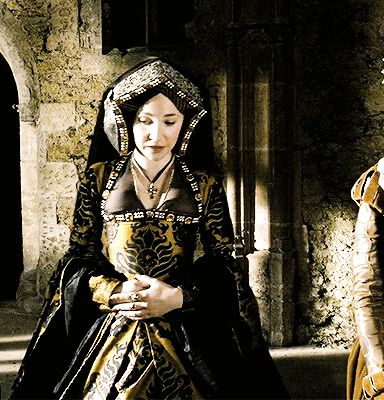
Like her father, Gertrude walked on eggshells trying not to displease the King, but ultimately it was impossible for her to accept Anne Boleyn as the new Queen. The Catholic Marchioness soon found herself in a position of open defiance of Henry VIII and his second wife. Gertrude gave ear to the Nun of Kent’s prophecies (for which the Nun was executed in 1534). She remained fiercely loyal to Katherine of Aragon and Princess Mary in their fell from grace. She exchanged letters with Eustace Chapuys, ambassador of the Holy Roman Emperor Charles V, and even visited him in disguise during the period when it was dangerous to become Henry VIII’s enemy. How much Gertrude knew of the proposed match between Reginald Pole and Princess Mary remains unknown, but she certainly favoured the idea of the Anglo-Imperial war. In late 1535, Katherine of Aragon’s health began to deteriorate and it became clear to everyone that she was mortally ill. She died on 7 January 1536 amid rumours of poisoning.
Sources:
Sylvia Barbara Soberton, The Forgotten Tudor Women: Gertrude Courtenay. Wife and Mother of the last Plantagenets
https://tudorsdynasty.com/ten-things-you-didnt-know-about-gertrude-courtenay-marchioness-of-exeter/?amp=
#catherine of aragon#katherine of aragon#catalina de aragon#henry viii#gertrude blount#gertrude courtenay#anne boleyn
25 notes
·
View notes
Quote
It is [Katherine of Valois]'s refusal to submit to male authority, as much as her wish to remarry, that lays her open to the accusation that she was governed by her lust, because her behaviour, from the lords’ perspective, was unwise, ill-advised, and reckless. In addition to Katherine’s disobedience they likely also felt disappointed in her. She had been married to a revered king, around whose memory an intense culture of commemoration flourished. Even without the potential problem of an influential stepfather for Henry VI, Katherine’s wish to marry any man, let alone a mere Welsh squire, was a profound betrayal of Henry V’s memory.
Katherine J. Lewis, “Katherine of Valois: The Vicissitudes of Reputation” | Later Plantagenet and the Wars of the Roses Consorts: Power, Influence, and Dynasty (2023)
It is conceivable that Katherine’s actions were viewed by those lords as proof of her wrongheadedness and expressed by them in the misogynistic terms conveyed by the chronicler. While this may have been how Katherine was regarded by some at court, there is no evidence that this was how she was viewed more widely. As noted above, her marriage was not publicly known, and she was not in disgrace.
#catherine of valois#owen tudor#henry v#historicwomendaily#historian: katherine lewis#later plantagenet and the wars of the roses consorts
104 notes
·
View notes
Text
I would just like to state again, for the record, that freaking no one does opening paragraphs like Shirley Jackson does opening paragraphs.
Like everyone knows The Haunting of Hill House, but it bears repeating:
“No live organism can continue for long to exist sanely under conditions of absolute reality; even larks and katydids are supposed, by some, to dream. Hill House, not sane, stood by itself against the hills, holding darkness within; it had stood so for eighty years and might stand for eighty more. Within, walls continued upright, bricks met neatly, floors were firm, and doors were sensibly shut; silence lay steadily against the wood and stone of Hill House, and whatever walked there, walked alone.”
And that is incredible enough, that is already one of the best openings to a novel in history, but THEN.
Then we have We Have Always Lived In The Castle!!!
"My name is Mary Katherine Blackwood. I am eighteen years old, and I live with my sister Constance. I have often thought that with any luck at all I could have been born a werewolf, because the two middle fingers on both my hands are the same length, but I have had to be content with what I had. I dislike washing myself, and dogs, and noise. I like my sister Constance, and Richard Plantagenet, and Amanita phalloides, the death-cup mushroom. Everyone else in my family is dead."
Has any opening paragraph ever made me want to know more about a character? No! I don't think so! I am fucking obsessed with Merricat and I want to put her in a jar and study her like a bug!
Like I'm always impressed with Jackson's craft, but opening paragraphs are so hard. They are so hard! And she always seems to craft one that draws you right into the web of horror that she's creating in that book. You're always pulled right into that house, whether it's lurking the halls of Hill House, not sane, or the incestuously isolated Blackwood residence. You're drawn into that madness instantly, and instantly you understand these characters who will not be understood by those around them.
I love the way she can draw you into the POV of protagonists who simply do not interact with reality to the point where you become comfortable living in their version of reality, too. You get them even as it fascinates and horrifies you. I feel like that's one reason why her books are so effective.
Every mind can break, but every mind does so in such a specific way. And it's the specificity of the madness and the ability to convey it in a way that makes you feel it, too, y'know? You come to realize that these women could never have been anything else, could never have been sane, because they live in homes that are... well, not sane. Their world is not sane, so how could they be? How could any of us be?
So you get pulled into this whirlpool of reality-shifting madness and deeply unreliable narrators and when you finally free yourself at the end of the book, you feel like you're walking back out into the sun squinting, dazed. Confused to find yourself back in a reality that makes some semblance of sense, but unable now to ignore the seams in it.
Goddamn, what an artist.
#but it's also almost impossible to truly adapt the interiority of her novels to screen#which is I guess why some filmmakers did not even fucking try#I say not naming names
31 notes
·
View notes
Note
24 and 25 for the history ask?
24: Who do you consider to be one of the most underrated historical figures?
edward vi. henry vii and mary i are rightfully recognised and understood as similarly underrated in comparison to their successors, but they do have their advocates - unlike edward vi. i've encountered a lot of tudor enthusiasts, and nobody ever lists edward as their favourite tudor or favourite historical figure. of course, he died as a child and spent a good half of his reign with limited input into how he ruled, but in his short life he achieved a remarkable amount of change, plenty of which was his own work.
edward's legacy is hugely unfair. he's remembered, for the most part, as a sickly and weak child overpowered by the cruelty of his regents. but this is, in my opinion, a terrible way to view him. he was powerful. he was intelligent. he was raised to rule. he managed to handle his uncle kidnapping him; he helped shape what would have been the future of english protestantism; he began trying to solve the huge amounts of debt that his father and uncle had left him in. the main reason he is not remembered as an efficient king with a powerful and skilled advisor by his side (john dudley may not have been the most consistent person around, but i think his legacy also got fucked over by edward's untimely death) is that he died young. had he lived, he might have fathered an heir, finally secured the tudor succession (a problem which remained essentially unsolved across the entire period), fully established a church of england, reduced the financial problems of henry viii, and perhaps become involved with colonialism across the seas. (not that that's a good thing, but elizabeth i isn't exactly shunned for her involvement in ireland...)
and most of all, edward was human. he was a teenager with his own thoughts and feelings, ranging from his turbulent and tragic relationship with his sister, mary, to his grief over the death of his mother. he was orphaned at the age of nine. two of his uncles were beheaded when he was only eleven and fourteen respectively. he was overcome with sorrow when his friends, the dukes of suffolk, died. he once wrote of mary: 'i love you most.' but at christmas in 1550, they got into a row and made each other cry because they couldn't reconcile their religious beliefs - mary refused to bow to edward's religious changes, and edward was frustrated that mary insisted he was too young to know his own beliefs. he was close friends with lady jane grey, whom he later tried to make his heir. and he was fifteen! he died slowly and painfully, over a period of six months, and he was a teenager who knew that his entire life's work might be undone by his sister. he was stubborn, he was clever, he was deeply religious - all traits for which his sisters and father are well-known, but edward is denied. i want a proper drama focusing on edward's life, and NOT his annoying uncle or elizabeth, stat.
i was going to say something about margaret pole and arthur plantagenet here, but i got sidelined by my love for edward here. arthur was the illegitimate son of edward iv (who, funnily enough, died in the tower of london), and margaret was the daughter of george, duke of clarence, and niece of edward iv. neither of them were particularly important in edward iv or richard iii's reigns, but they later became much more relevant in the tudor era, as relatives of elizabeth of york and then henry viii. under henry viii, arthur was viscount lisle and lord deputy of calais - oddly enough, after his death, his title passed to john dudley, who was his stepson. margaret was mary i's governess, and her family remained staunch supporters of katherine of aragon. despite refusing to accept mary as his heir, henry apparently considered women a legitimate threat to his rule, as he executed margaret in 1541. earlier, he also arrested arthur. arthur was supposed to be released, but he died a few days after being freed, probably from a heart attack. they're the real last plantagenets.
i'll stop there, else this post will end up miles long.
25: Who is the most overrated historical figure, in your opinion?
stalin. elizabeth i. other people who weren't involved in colonialism, probably. oh yes! anne boleyn. we have all heard of anne boleyn, we get it, she was a person who existed. the actual woman anne boleyn seems really interesting, but unfortunately it gets buried under leagues of people more interested in either her romance with henry viii (boring) or people who simply wish to one-up those who aren't interested in her specific area of history. i am genuinely fascinated by henry viii, but i'm exhausted by the constant emphasis on anne boleyn this, elizabeth i that. i'm not interested in them!! i don't care!! but they're everywhere and fans of anne boleyn seem to feel oppressed for caring about an incredibly popular historical figure. not that anne wasn't treated with a lot of cruelty by henry viii and a lot of catholics both at the time and after the fact, but is there any historical figure except maybe her daughter who saturates all things tudor? i doubt it
(link)
19 notes
·
View notes